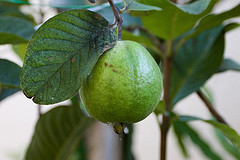Guavas
| Infobox on Guavas | |
|---|---|
| Example of Guavas |  |
| Freshness facts | |
| Optimum carrying temperature | 5°C to 10°C |
| Highest freezing point | - |
| Acceptable product temp. at loading into containers | Max. 2°C above carrying temperature |
| Optimum humidity | 90% |
| Ventilation setting for containers | 10 m³/hr |
| Storage life | 2 to 3 weeks |
| Climacteric / non-climacteric | Climacteric |
| Ethylene production | Low |
| Ethylene sensitivity | Medium |
| Modified / controlled atmosphere | 10% to 30% CO2; 2% to 5% O2 |
| Potential benefits | Some benefit is exhibited but in most instances CA probably not worthwhile |
| Availability | |
| Australia South Africa |
March - April December - May |
Guavas
Contents
Harvesting and handling
The Guava fruit is spherical to pyriform, with a persistent calyx at the distal end. The thin smooth skin encloses a granular pulp which is white to pink in colour. In the centre the flesh is soft, and in it are embedded numerous small seeds. Some varieties have only a few seeds, while others have a large cavity full of seeds. Ripe guavas have a distinctive aroma and the taste of a sweet apple; they are nutritionally valuable for their high vitamin C content.
It has been established that guava is a climacteric fruit. Fruits picked when almost ripe have the best eating quality but cannot be stored. Fruits for export are harvested mature green, various maturity indices being used to determine the optimal picking date. Care during harvesting is necessary to prevent damage to the skin and consequent development of postharvest rots.
Guavas are sensitive to physical damage during harvesting and handling all the way to the consumer. Symptoms include skin abrasions and browning of bruised areas, which are very susceptible to decay. MAP in polyethylene bags and use of wax-coatings delays ripening and softening. Skin blackening is a problem when some wax coatings are applied.
Postharvest desiccation is a major problem, leading to a dull yellow, sometimes wrinkled skin.
Cooling and storage
Mature green and partially ripe fruit can be held for 2 to 3 weeks at 8°C to 10°C. Ripe, soft fruit can be held about 1 week at 5°C to 8°C. Shelf-life is about 7 days when stored at 20°C.
Chilling injury symptoms include failure of mature-green or partially-ripe guavas to ripen, browning of the flesh and, in severe cases, the skin, and increased decay incidence and severity upon transfer to higher temperatures. Fully-ripe guavas are less sensitive to chilling injury than mature-green guavas and may be kept for up to a week at 5°C without exhibiting chilling injury symptoms.
Ethylene treatment
Ethylene treatment can accelerate ripening of mature-green guavas to full-yellow stage at 15-20°C and 90-95% relative humidity. This treatment results in more uniform ripening, which is more important for guavas destined for processing. Immature-green guavas do not ripen properly and develop 'gummy' texture.
Controlled atmosphere
Short-term treatment (24 hours) with 10% O2 + 5% CO2 before storage in air at 4°C for 2 weeks delays colour development and reduces chilling injury, compared to fruit held in air.
Storage disorders
Anthracnose, Aspergillus rot, Mucor rot, Phomopsis rot, Rhizopus rot.











